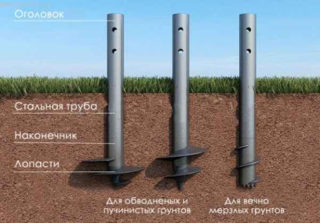A building made of aerated concrete stones weighs a little compared to a brick or concrete building. The foundation of the house does not undergo heavy loads, so you can save on it. Aerated concrete house on screw piles is a suitable solution for private housing construction. The parameters of the screw-in elements are determined taking into account the weight of the building and geological studies of the soil. Buildings up to three stories high are made of porous concrete.
Types of foundations for aerated concrete house
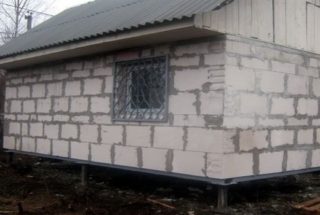
Lightweight concrete with gas filling has a disadvantage in the form of fragility, because of this quality, the walls crack at the slightest subsidence of the soil under the foundation. Strip foundations can only be made of shallow depth, because low planting bases will squeeze out lateral soil pressure. At deep supports, the lateral sides experience indirect stress, and the low weight of the structure cannot keep the structure from being pushed out by the heaving layer.
The foundation of a house made of blocks on screw piles is least of all exposed to pulling, twisting and bending forces. the walls have a small surface and are supported by the tip on a solid layer of earth. Support rods have sufficient rigidity, they are little deformed during the construction of a house and operation. The foundation of the building made of aerated concrete is chosen taking into account stability in the soil so that the walls do not experience fracture loads.
Columnar
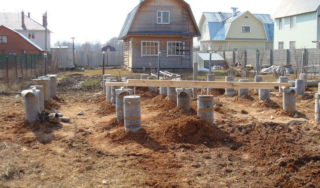
The pillars are placed at important points along the perimeter of the building. On such a basis, little money is spent, but the application is limited by some conditions. You cannot put pillars if the house is being built on a slope with a large difference in heights on one site. Landslide and loose soils are not suitable for columnar base.
Requirements for the foundation:
- a solid layer of earth with a low level of soil liquid is used;
- the heel of the element is located below the freezing mark by 20 - 30 cm;
- to the bottom of the pillar, it expands like a glass to increase the support quadrature;
- the rigidity of the structure is given by a reinforced concrete grillage.
Pillars are square or round, the material is wood or reinforced concrete, sometimes metal supports with insulation are made. The grillage is poured into the formwork with the preliminary installation of the reinforcing cage.
Monolithic
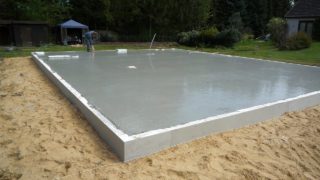
It is a solid slab of concrete with stiffening ribs, in which metal rods are installed for reinforcement. They are mounted so that the bottom and side surfaces do not come into direct contact with the soil and do not absorb moisture. For this, various pillows of sand, gravel, crushed stone are made, geotextiles are laid under the base.
Types of monolithic slabs:
- an in-depth version is made below the freezing mark, used in the construction of buildings with a basement;
- a floating view or not recessed is placed on the surface if there is no basement.
In the construction of the foundation slab, two concrete layers are made (preparation and slab), a reinforcing cage in the crossbars for rigidity, a metal mesh is placed over the entire area, waterproofing and protection from the cold are laid. They take concrete of the M250 and M300 brands, antifreeze modifiers and additives against moisture absorption are added to the mixture.
Tape
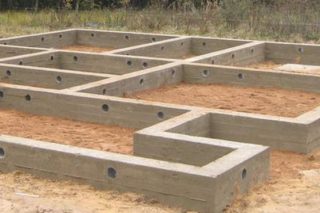
A deepened monolithic foundation for a house with walls made of aerated concrete is not used, they make a base with a shallow immersion depth. Shallow concrete tapes are positioned so that their sole is in the zone of soil freezing. The option is suitable for dense earth, and in intumescent layers it will be squeezed out when it freezes. If the layer contains moisture or is fed by it from rain and snow, over time the shift will lead to cracks in the walls.
It is undesirable to build a strip foundation under the walls of a long-distance aerated block. Concrete does not work well in bending and stretching, so an increase in length leads to a loss of strength. It is necessary to lay sand and gravel bedding, lay geotextiles and insulate structures.
Benefits of a screw foundation
The best option is to build aerated concrete walls on a pile foundation. So the vertical fences of the house will receive stability and will not collapse from shifts.
Screw posts in the form of supports have positive qualities:
- racks with blades are easily and quickly screwed in, it takes about 20 - 30 minutes to install one element;
- the installation of piles does not depend on the relief of the construction site, the support rods are placed on the slopes, where concrete overruns will be for a monolithic base;
- can be placed in wet and landslide soils, if the end of the pile rests on solid ground.
Thanks to the screw nozzles, the grip on the ground increases and the ejection forces are not triggered. The deepening point is below the freezing depth. The installation of screw piles can be carried out at any time of the year.
Construction stages
Stages of the device of the pile screw foundation:
- design and structural calculations;
- geological assessment of the construction site;
- carrying out static and dynamic tests at the construction site;
- marking the site and transferring the plan to the area;
- installation and screwing of piles;
- checking the horizontal level of the heads and cutting off the ends of the piles;
- installation of formwork and pouring the grillage or monolithic slab;
- quality control at the stage of deepening and after the end of work.
When building a house made of aerated concrete on piles, the weight of the building and the quality of the land under the future structure are taken into account. On sale there are elements with different characteristics in terms of load, section, material. For aerated concrete walls, piles with a diameter of 89 mm and more, produced by the injection method, are taken. Sometimes welded elements are taken into operation, but after a preliminary calculation.
The calculation of the number of screw piles is performed by technical specialists, since collecting loads from home requires precision and specific knowledge. The weight of the slabs is distributed to the walls, and they transfer the load to the foundation. The force from the roof also acts. Wind and snow loads are taken taking into account the coefficients that are given in the SNiP tables. The figures show the influence of the windage of the roof, its slope, the height of the ridge and the location relative to the wind rose on the magnitude of the transmitted voltage.
Installation of screw piles
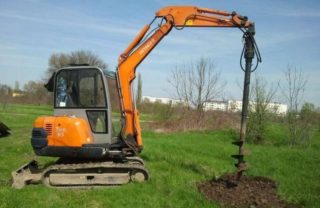
The equipment is delivered to the object, which will twist the piles. Racks are stocked and prepared for installation. Test support rods are screwed in several places on opposite sides of the plan and readings are read from instruments to confirm the bearing capacity of the racks in fact.
The pile is placed in the funnel with a hydraulic jack. Motorized drills, pit drills, pile screws are used - the mechanisms greatly speed up screwing in comparison with the manual method. Smooth piles are placed using the hammering method, and screw piles with blades are screwed into the ground.
If the piles are small, then two workers are enough for manual screwing. A welded device in the form of a glass with ears, into which a scrap is inserted, is put on the head of the pile.
Pipes of larger diameter are put on both ends, the vertical is checked with a plumb line or a laser level and slow twisting begins. The work continues until the piles fail to enter the soil. This means that the point has reached a solid layer or stumbled upon a stone.
The mechanisms more accurately center the rod in the funnel and twist with the smallest deviations, but the use of machines is justified when the depth of the pile is large and the diameter of the piles is impressive.

